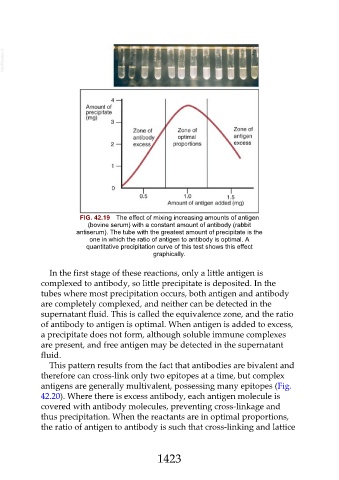Page 1423 - Veterinary Immunology, 10th Edition
P. 1423
VetBooks.ir
FIG. 42.19 The effect of mixing increasing amounts of antigen
(bovine serum) with a constant amount of antibody (rabbit
antiserum). The tube with the greatest amount of precipitate is the
one in which the ratio of antigen to antibody is optimal. A
quantitative precipitation curve of this test shows this effect
graphically.
In the first stage of these reactions, only a little antigen is
complexed to antibody, so little precipitate is deposited. In the
tubes where most precipitation occurs, both antigen and antibody
are completely complexed, and neither can be detected in the
supernatant fluid. This is called the equivalence zone, and the ratio
of antibody to antigen is optimal. When antigen is added to excess,
a precipitate does not form, although soluble immune complexes
are present, and free antigen may be detected in the supernatant
fluid.
This pattern results from the fact that antibodies are bivalent and
therefore can cross-link only two epitopes at a time, but complex
antigens are generally multivalent, possessing many epitopes (Fig.
42.20). Where there is excess antibody, each antigen molecule is
covered with antibody molecules, preventing cross-linkage and
thus precipitation. When the reactants are in optimal proportions,
the ratio of antigen to antibody is such that cross-linking and lattice
1423

